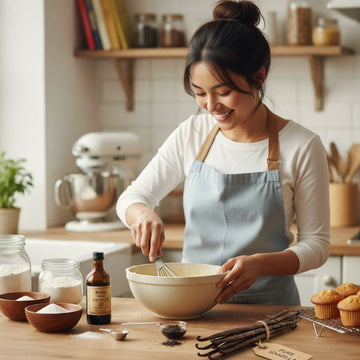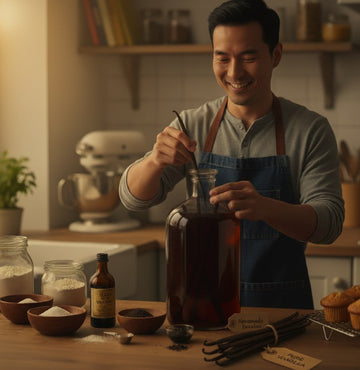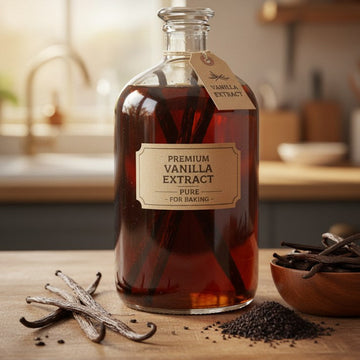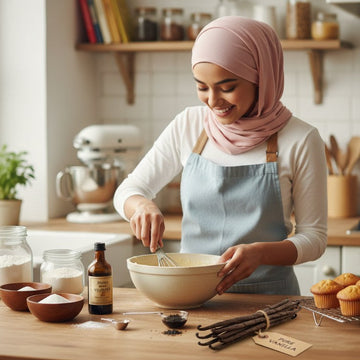Homemade vanilla extract lives or dies by the beans you choose. The right species, grade, and freshness determine how deep, aromatic, and balanced your final extract will be. Use this guide to pick beans with confidence and craft a bottle you’ll be proud to bake with.
The Best Beans for Extract
Choose the Right Species
-
Vanilla planifolia (Bourbon-style): High vanillin, classic “true vanilla” with warm caramel/cocoa notes. Produces a robust, versatile extract perfect for everyday baking.
-
Vanilla tahitensis (Tahitian-style): Softer, floral, and fruity (cherry/anise nuances). Lower vanillin but high aromatic complexity—great for creams, fruit desserts, and white chocolate.
Expert tip: Blend 70% planifolia with 30% tahitensis for a layered extract that’s both bold and perfumed.
Pick the Optimal Grade
-
Grade B (Extract grade): Slightly drier, concentrated, and cost-effective—top choice for extraction.
-
Grade A (Gourmet): Higher moisture, intensely aromatic; also excellent if you want a faster-starting, fragrant extract.
-
Grade C: Lean and economical for large-batch extract where appearance doesn’t matter.
What Freshness Looks Like
Pods should be flexible (not brittle), dark brown to black with a gentle sheen, and carry a clean, sweet aroma. Avoid musty or split, bone-dry beans.
Proven Ratios (Bean Load)
-
Single-fold extract: 6–8 whole beans per 1 cup (250 ml) of 35–40% ABV alcohol (vodka is neutral; rum/bourbon add character).
-
Double-fold extract: 12–16 beans per 1 cup (250 ml) for twice the intensity and less added liquid in recipes.
Step-by-Step: How to Make Vanilla Extract
-
Prep the beans: Split lengthwise to expose the seeds; cut into shorter pieces if needed to submerge.
-
Bottle: Place in a sterilised glass jar and cover completely with alcohol. Seal tightly.
-
Steep: Store cool and dark for at least 8–12 weeks; shake weekly.
-
Mature: Peak complexity develops between 3–6 months. You can strain or leave beans in and top up with alcohol as you use it.
Alcohol-Free Option (Glycerite)
Use food-grade vegetable glycerine instead of alcohol for an alcohol-free extract. Expect a thicker, naturally sweet result; steep times are similar, and flavor is gentler.
Pro Tips for Maximum Flavor
-
Blend origins: Indonesian/PNG planifolia for backbone; add PNG/Tahitian tahitensis for aroma.
-
Mind temperature & light: Heat and UV flatten aromatics; keep bottles cool and dark.
-
Don’t rush it: Time unlocks complexity—thin, early extracts never catch up.
-
Reuse smartly: After decanting, dry spent beans to grind into vanilla powder or bury in sugar for vanilla sugar.
Common Mistakes to Avoid
-
Too few beans: Leads to weak, one-note extract. Stick to the ratios.
-
Low-proof alcohol: Below ~35% ABV risks poor extraction and spoilage.
-
Overexposure: Sunlight and warmth strip volatile aromas quickly.
Quick Buying Checklist
-
Grade B (or A) pods that are flexible and aromatic
-
Clear origin and species (planifolia, tahitensis)
-
Vacuum-sealed or freshly packed, recent pack date
-
Typical length and moisture range provided
Ready to source premium beans for powerhouse extract? Shop sustainably sourced Vanilla Beans with fast Australian delivery at https://www.banyanvanilla.com.au/








